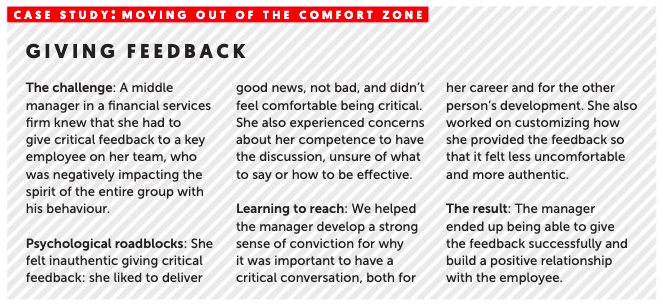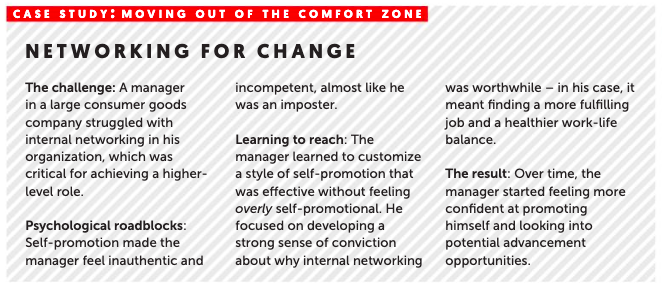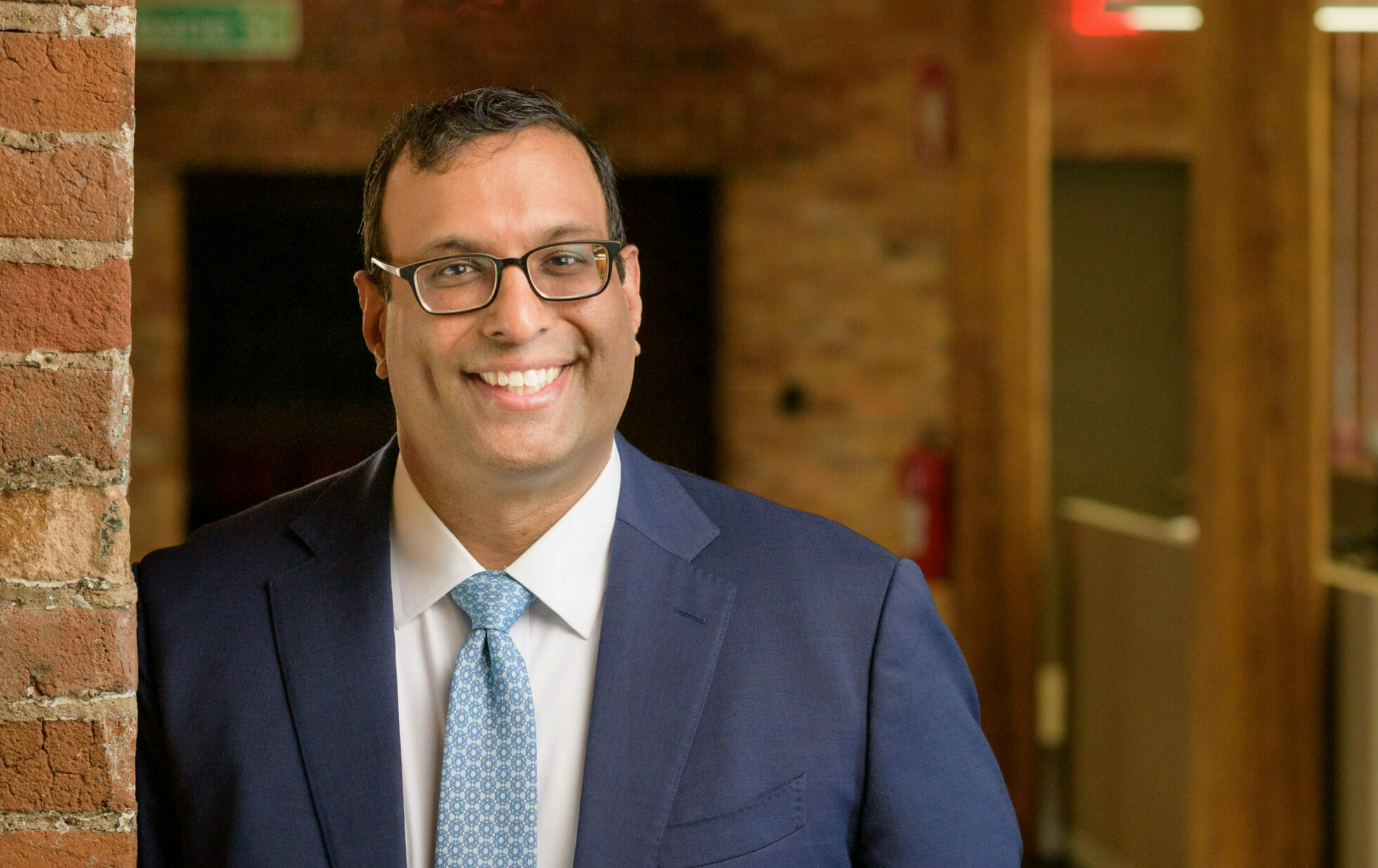Andy Molinsky shares 3 techniques to stretch yourself for career and personal growth.
You know it’s time to have that uncomfortable conversation with your coworker, but you keep avoiding it. You want to network more, but feel awkward striking up conversations with strangers. You should be more vocal about your career accomplishments, but hate to toot your own horn.
We all face a long list of uncomfortable but necessary tasks at work. With constant change in our lives and in our organizations, that list is only going to get longer. We’re continually changing roles: from individual performer to manager; from manager to executive; and from executive to chief executive. Each of these changes comes with a ‘stretch’ in our roles and responsibilities, which forces us out of our comfort zone and poses a challenge to our skills and personalities.
The problem, of course, is that acting outside our comfort zones can be incredibly challenging. People-pleasers often dread delivering bad news, sometimes avoiding the situation altogether because of how uncomfortable it feels. Introverts can struggle with having to ‘schmooze,’ work a room, or pitch their products. And it can be terrifying for anyone with a fear of speaking in public to step up to the platform to deliver a speech. But this is the reality at work: as we grow and learn and advance in our jobs and in our careers, we’re constantly faced with situations outside our comfort zones where we need to adapt and adjust our behavioral styles.
As a management professor and consultant to businesses, I have seen this inability to step outside one’s comfort zone derail careers and threaten productivity. And, to be honest, stepping outside my own comfort zone has been a challenge throughout my own career.
In my first professional job as a professor, I was quite tentative in faculty meetings. I wasn’t sure what to say, or whether what I wanted to say had any merit. Another challenge has been public speaking. I have had to learn to be more direct and authoritative; to project confidence in a way that isn’t necessarily my go-to demeanor.
The cycle of avoidance
As I’ve learned from the past decade of research, writing, speaking and consulting on this topic, I’m definitely not alone in wrestling with situations that take me outside my comfort zone. Very experienced and successful professionals routinely struggle with situations outside their comfort zones and go to great lengths to avoid these situations, even if they are key for effective performance. They may avoid the situation entirely, perhaps by putting off that difficult conversation, or declining the invitation for public speaking. They may procrastinate or pass the buck; or they may substitute something easier, like emailing potential clients instead of taking on the harder option of a face-to-face conversation. This is another form of avoidance and it is usually likely to lead to a less effective outcome.
This is what we describe as the cycle of avoidance. In the short term, it can offer relief; but the long-term effect is to increase worry and anxiety. Avoidance is not a solution.
Breaking out
As a victim of the very same challenges that plague otherwise accomplished professionals, I wanted to figure out a solution to this challenge. I conducted research across occupations to understand why people struggle to step outside their comfort zones, and what distinguishes those who overcome these challenges from those who don’t. I interviewed more than 100 people, from managers and executives and entry-level employees, to doctors, educators, lawyers and small-business owners – as the basis for my book, Reach, and a corporate development program, the Reach Method.
There are three steps in the process for helping individuals and companies to discover their capacity to be agile in the face of change, and to learn how to successfully step outside their comfort zone.
Step 1: Diagnose psychological roadblocks
A critical first step in shaping a plan of attack for learning to step outside your comfort zone is to diagnose the factors holding you back. I typically find five different psychological roadblocks.
The first is the Authenticity Challenge. This is the idea that acting outside your comfort zone can feel fake, foreign, and false. These feelings can cause discomfort when attempting to adapt behavior, or cause people to avoid the situation entirely.
The second is the Competence Challenge. In addition to feeling inauthentic, people struggling to act outside their comfort zone can also feel that they lack the ability to be successful. When that’s the case, they can feel anxious, self-conscious, and even embarrassed, which makes it even harder to adapt and adjust behavior.
Roadblock number three is the Resentment Challenge. Even if people logically know that they need to change their behavior to be effective in a new situation, they may psychologically feel resentment or frustration about being constrained or forced to stretch beyond where they’re comfortable.
Fourth is the Likeability Challenge: one of the greatest worries people feel when stretching outside their comfort zones is whether people will like this new version of themselves. This challenge is especially pertinent to people who, by nature, are people-pleasers or conflict-avoiders.
Finally, the fifth roadblock is the Morality Challenge. In certain instances, people can have legitimate concerns about the morality of the behavior they’re about to perform.
Of course, people don’t necessarily experience all of these roadblocks each time they attempt to change – but even one or two can be enough to keep people fully ensconced within their comfort zones.
Step 2: Identify and embrace your personal source of conviction
Conviction is the deep sense of purpose that the hard work entailed in stepping outside your comfort zone is worth it. What’s critical is that this source of conviction is authentic and meaningful to you.
For example, I recently worked with a group of lawyers who were uncomfortable with selling themselves and pitching their services to clients. However, by reflecting on the meaningful impact that their past work has had for clients – helping those clients to achieve their goals and to avoid painful and costly disruption – we were able to reframe “selling” as “helping.” This made the lawyers far more comfortable with the act of selling their services.
Step 3: Learn to customize your behavior
It was one of the biggest ‘a-ha’ moments in my work – realizing how the most successful performers were able to find a way to make a situation they had feared into something that benefited them. This is the third step: learning to customize your behavior in a way that makes the task more natural and authentic. It is possible to develop the ability to tweak or adjust – often in a slight, but meaningful, way – how you perform a task, in order to make it feel more comfortable and natural.
Such tweaks and adjustments might be made by altering your language, or your body language; or it could be done by playing with the timing of an event, or adjusting the context. Take networking. It can be terrifying, even – or especially – for someone who knows they need to do it for the business to get customers. Yet while you might feel helpless, you have more power than you think. For example, you might decide to not go alone to an event, and ask a colleague to join you. You might decide to choose events when you’re at your best: if you’re a morning person, target breakfast events. You might choose to go to events at the very start: even huge events don’t start out huge but build up over time. If you get there at the beginning, it may be a little less intimidating.
Alternatively, you might prepare a few opening lines for the conversations ahead, find a prop to bring with you to help introduce your business, or choose to wear your ‘power suit.’ The point is that there are lots of ways you can customize your behavior, or the situation you’re facing, to make it just a little bit more familiar and comfortable – ultimately, helping to put it more inside your comfort zone.


In the end, there’s no magic to stepping outside comfort zones. It takes time, effort, strategy, and determination. But with a solid plan in place and the motivation to carry it out, you’ll be surprised at what you can achieve.
— Andy Molinsky is a business school professor, author of Reach and Global Dexterity and the creator of The Reach Method. This article first appeared on dialoguereview.com.



